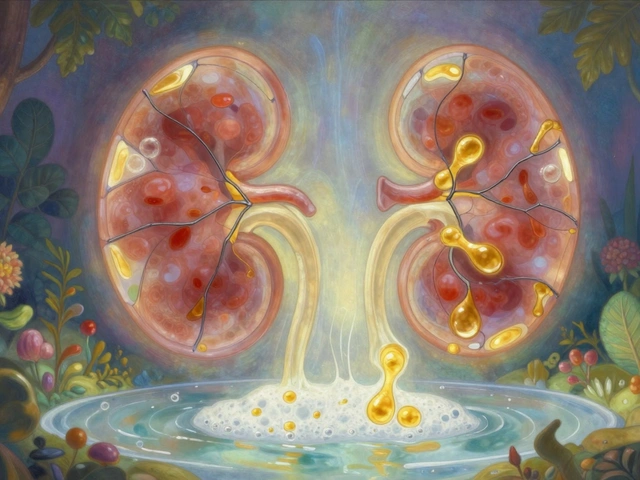If I told you there was a new medicine that could lower your chance of dying from heart failure more than some of the old go-to pills, would you believe me? That’s sacubitril for you. In just the last few years, doctors have been shaking up their game with this one, adding it to prescription lists for patients who might have been stuck with the same medications their whole lives. But does sacubitril actually live up to the hype? Or does it just pack a fancier price tag?
How Sacubitril Works Compared to Other Heart Failure Drugs
Let’s talk about what makes sacubitril special. Sacubitril isn't usually taken alone—it's paired with valsartan in a combo pill called Entresto. This duo is classified as an ARNI (angiotensin receptor-neprilysin inhibitor). Traditional heart failure drugs, like ACE inhibitors (think lisinopril or enalapril) and ARBs (like losartan or candesartan), lower blood pressure and help the heart pump with less stress. They block some pretty tough chemicals in your body that make the heart work harder than it should.
Sacubitril does more. It blocks an enzyme called neprilysin. Why should you care? Because that enzyme breaks down proteins that help your blood vessels relax and get rid of extra salt and water. By blocking neprilysin, sacubitril lets these helpful proteins go to work, which means your heart doesn’t have to struggle as hard. Now, valsartan—sacubitril’s partner—acts similar to those ARBs I just mentioned. So the team-up gives you double the benefit: dumping the bad stuff and letting the good stuff flow.
On the other hand, you’ve got the usual suspects. Beta-blockers, such as carvedilol and metoprolol, slow down the heart rate and help it fill up with blood more efficiently. Diuretics, like furosemide, just help you pee out the extra fluid. Then there are those mineralocorticoid receptor antagonists, with heavy names like spironolactone, which block hormones that can stiffen your heart or make you hold salt.
Here’s where things get interesting. A landmark study in 2014—the PARADIGM-HF trial—stacked sacubitril/valsartan against enalapril, a top ACE inhibitor. Ready for a stat that changed the game? The group taking sacubitril/valsartan had a 20% lower risk of dying from cardiovascular causes or being hospitalized for heart failure. That’s not a small difference. When it comes to heart failure, lowering your hospitalization and death risk by a fifth is huge.
Of course, sacubitril/valsartan isn’t the answer for every single person. Some folks have too low blood pressure, kidney problems, or angioedema, and they might need to stick with the tried-and-true options. But for someone who can tolerate an ARNI, the benefit is crystal clear.
| Medication | Class | Main Benefit | Death/Hospitalization Reduction (vs. placebo) |
|---|---|---|---|
| Sacubitril/valsartan | ARNI | Dilates blood vessels, reduces workload, blocks bad enzymes | ≈20% (vs. ACE inhibitor) |
| ACE inhibitors (ex: enalapril) | ACE inhibitor | Lowers blood pressure, reduces heart strain | ≈15-20% |
| Beta-blockers (ex: carvedilol) | Beta-blocker | Slows heart, improves filling | ≈30% |
| Spironolactone | MRA | Cuts out bad salt hormones | ≈30% |
| Furosemide | Loop diuretic | Removes fluid | Symptom relief |
The only catch? Some patients might feel dizzy or get low blood pressure from sacubitril/valsartan. And—this is important—you can’t mix it with an ACE inhibitor, or you might seriously increase your risk of angioedema, which is no joke. Always give the body two days without ACE inhibitors before starting sacubitril/valsartan.

Real-Life Impact: Are Patients Actually Benefiting?
Numbers on charts are nice, but what does this actually mean when you go to your doctor or fill a prescription? People with heart failure notice something tangible. With sacubitril/valsartan, patients say they find it easier to do simple activities like walking to the grocery store or climbing stairs. It’s not magic—you won’t be running marathons overnight—but life gets less exhausting.
Doctors also report fewer emergency visits. Hospitalization isn’t just a scary word; it means time away from work, home, and family. Every day in the hospital chips at your confidence and costs you money. That’s why that 20% reduction in risk feels so real.
Now, let’s talk about costs. Sacubitril/valsartan is definitely pricier than ACE inhibitors or beta-blockers, especially when those older meds are generic and dirt cheap. Insurance might balk, but some programs help cover the extra cost, especially if you’ve already tried the regular meds and need an upgrade.
Not everyone’s the same. Some folks find the cough and swelling with ACE inhibitors unbearable. Others have real problems with spironolactone—breast tenderness, high potassium. Sacubitril/valsartan brings its own headaches, like risk of low blood pressure or kidney bumps. The trick is for your doctor to know exactly what to look for and check your labs on the regular. Also, make sure you’re not dehydrated because losing too much salt and water can leave you flat.
One really interesting fact? In clinical studies, people over 75 actually had similar benefits from sacubitril/valsartan as the younger crowd. Sometimes, older patients get left out of new treatments, but this one fits all ages—with the right oversights. That's a big win for anyone who thinks age should limit good care.
If you’re reading this for tips: always ask your doctor if you’re getting the most up-to-date meds. Don’t be shy. Bring up sacubitril/valsartan’s track record. And be ready to ask: “Will my insurance help cover this?” If you’re newly diagnosed or can’t shake the symptoms, it might be time to upgrade your heart failure game plan.

Choosing the Right Medication: Factors to Weigh
No two hearts are the same, so picking a medication isn’t like grabbing socks out of a drawer. If you’ve got kidney problems, some drugs can make things worse. Diuretics might help you feel less bloated but leave you dizzy if your blood pressure dips too low. ACE inhibitors and ARBs are usually first in line, but if you can handle them with no swelling or bad reactions, sacubitril/valsartan may be the next best thing.
If you’ve had angioedema with an ACE inhibitor, skip sacubitril/valsartan. If your blood pressure is already on the thin side, your doctor might lower your starting dose. People with severely reduced ejection fraction—meaning their heart is barely getting blood around—tend to benefit the most from sacubitril/valsartan. Folks with a preserved ejection fraction or more mild symptoms might see less obvious results. So, where do you fit?
Let’s not forget drug interactions. Sacubitril/valsartan can raise potassium levels. If you already take potassium-boosting drugs (like spironolactone), your doctor will need to keep a close eye. And don’t stop diuretics cold turkey—your body might hold onto fluid, making symptoms worse. Switching from an ACE inhibitor needs a two-day washout, remember that—skipping this step can be dangerous.
If you’re keeping a med list handy, here’s a quick resource:
- Sacubitril/valsartan: Best for most people with reduced ejection fraction, unless you’ve had angioedema or serious kidney issues.
- Enalapril or other ACE inhibitors: Still good, especially if price is a concern.
- Beta-blockers: Almost always needed along with other meds.
- Spironolactone: Great add-on, especially for folks with hard-to-control symptoms.
- Diuretics: For days when you’re puffy or short of breath, but not for everyone long-term.
If you’re choosing between options, weigh symptom relief (can I walk, breathe, sleep?), safety (any swelling, kidney bumps, coughs, or side effects?), and cost (will this blow up my budget?). Doctors sometimes throw new meds at people without reviewing the big picture. Always ask: “Will this medication help me live longer, or just feel better?” Sometimes both is possible—which is where sacubitril/valsartan often shines.
Don’t underestimate the power of labs and follow-up. Checking kidney numbers, potassium, and blood pressure after any med change is key. A drug that looks great on paper can turn on you if you’re not careful. The best way to tell is by watching real results—how you feel, how your labs look, and how many trips to the ER you’re skipping this month.
Bottom line? Sacubitril/valsartan has shaken up how we treat heart failure. It isn’t magic, but for a lot of people, it means a better, longer life compared to sticking with older meds alone. Don’t be afraid to ask if it’s the right choice for you—or if your doctor’s stuck in old-school habits. Your heart’s the one doing the work, after all.







Comments
Craig E
14 May 2025Reading through the nuances of sacubitril/valsartan feels like unwrapping a philosophical parable about modern medicine; its dual action of neprilysin inhibition and angiotensin blockade invites us to contemplate the delicate balance between innovation and tradition. While the numbers from PARADIGM‑HF are undeniably compelling, one must still weigh them against individual patient narratives, ensuring that the promise of reduced mortality does not eclipse the lived experience of side‑effects. In this way, the drug becomes not merely a statistic but a catalyst for deeper clinical reflection.
Marrisa Moccasin
14 May 2025Okay… you think pharma is just giving us a miracle pill??!! Let me tell you-big pharma loves the hype! They push sacubitril/valsartan because it sells like hotcakes, and the *real* agenda is hidden in those patents and secret trials!!!
Don't trust the glossy tables; they hide the cost, the side‑effects, the long‑term risks!!
Caleb Clark
15 May 2025Alright folks, let me break this down step by step so nobody feels left out, okay? First of all, sacubitril/valsartan (Entresto) is a game‑changer for many patients, and you really want to have a chat with your doc about it. Second, the study numbers are big-about a 20% reduction in death or hospitalizations compared to enalapril, which is huge!
Third, remember that you have to stop ACE inhibitors for a couple of days before switching, otherwise you could get angioedema-yes, that swelling in the face that can be super scary.
Fourth, watch your blood pressure; some people feel a little light‑headed when they start, so a low dose might be the way to go.
Fifth, keep an eye on potassium and kidney labs; the combo can raise potassium a bit, especially if you're also on a MRA like spironolactone.
Sixth, if you have a bad cough from an ACE inhibitor, this combo often helps because the ACE part is gone.
Seventh, for older patients (even those over 75) the benefits seem to hold steady, which is great news for that demographic.
Eighth, cost is an issue-yes, it's pricier than generics, but many insurance programs have assistance, so ask your pharmacist about co‑pay help.
Ninth, lifestyle still matters; take your meds, stay active, watch sodium, and keep those follow‑up appointments.
Tenth, never stop diuretics abruptly; they help control fluid, and a sudden stop can make you feel worse.
Eleventh, the drug works best in reduced ejection fraction heart failure, so if you have HFpEF the effect might be less obvious.
Twelfth, if you’ve ever had angioedema with an ACE inhibitor, steer clear of this combo; the risk isn’t worth it.
Thirteenth, many patients report being able to walk up stairs without gasping-a tangible quality‑of‑life boost.
Fourteenth, the medication isn’t a cure; it’s a tool, so keep all other heart‑failure therapies in place unless your doctor says otherwise.
Fifteenth, keep a medication list handy; mis‑management can lead to dangerous interactions.
Sixteenth, the bottom line: talk to your doctor, ask about Entresto, weigh the benefits versus costs, and make an informed decision that suits your life.
Eileen Peck
15 May 2025Great summary, Caleb! I’d add that monitoring labs every few weeks after a switch is key, and patients often feel a subtle boost in daily stamina. Also, don’t forget to adjust diuretics if blood pressure drops.
Oliver Johnson
15 May 2025This new drug is just another way for the global elite to control our health. They want us to believe a pricey pill will save us, while ignoring the simple truth: diet and hard work beat any pill. Wake up!
Taylor Haven
15 May 2025Oliver, you’re missing the point. The real story is how the pharmaceutical cartels engineered the PARADIGM‑HF trial to show a 20% reduction, yet they never disclosed the hidden arm of the study where patients on the combo had higher rates of kidney injury. The FDA was warned, but the press release was slick, full of glossy graphs, and the media ate it up. The truth is buried under NDA clauses, and if you dig deeper you’ll see that insurance companies were bribed to push the drug despite the risk profile. So before you champion a “simple” solution, remember that every statistic is filtered through the lens of profit‑driven research.
Don’t be fooled by the hype.
Sireesh Kumar
15 May 2025Listen up, everyone! Sacubitril/valsartan isn’t just another medication, it’s the star of a new era in heart‑failure therapy, and the drama surrounding its launch is just the tip of the iceberg. The studies show impressive numbers, but the real world is messy. If you’re lucky enough to have insurance that covers it, great-if not, you’re left paying a premium for a “miracle.” This is why clinicians need to stay honest and not let the pharma siren song dictate treatment choices.
Jonathan Harmeling
15 May 2025While I appreciate the enthusiasm, let’s not forget the moral responsibility doctors have to weigh cost against benefit. Pushing an expensive drug when cheaper alternatives work for many patients feels ethically questionable.
Ritik Chaurasia
16 May 2025From my cultural perspective, heart disease is often seen as a family burden, and introducing a high‑priced drug like sacubitril/valsartan can widen the gap between those who can afford cutting‑edge care and those who cannot. This disparity fuels resentment and is a social injustice we must address.
Gary Marks
16 May 2025Oh please, Ritik, you always dramatize health inequities. Everyone knows the market decides who gets what. If you can’t pay, you’re out of luck-nothing new there. Stop whining.
Vandermolen Willis
16 May 2025👍 Great breakdown, everyone! I think the key takeaway is to have an open convo with your cardiologist. 💬 Keep those labs checked and don’t forget the lifestyle tweaks. 👟💊
Mary Keenan
16 May 2025This is too basic; anyone can read the label.
Steven Young
16 May 2025Sacubitril/valsartan is a decent option but only if you can handle the monitoring. Otherwise stick to what works for you.
Kelly Brammer
16 May 2025While the statement is factually correct, it overlooks the ethical imperative to provide patients with the most effective therapy available, regardless of cost, when clinically indicated.
Ben Collins
17 May 2025Oh wow, another “miracle” drug-because we definitely needed more hype. Maybe try walking a few extra steps before you buy the latest pharma hype train ticket.
Denver Bright
17 May 2025Ben, you’re missing the point: pharma isn’t the villain here, it’s the system that lets them profit while patients suffer. Stop the sarcasm and think bigger.